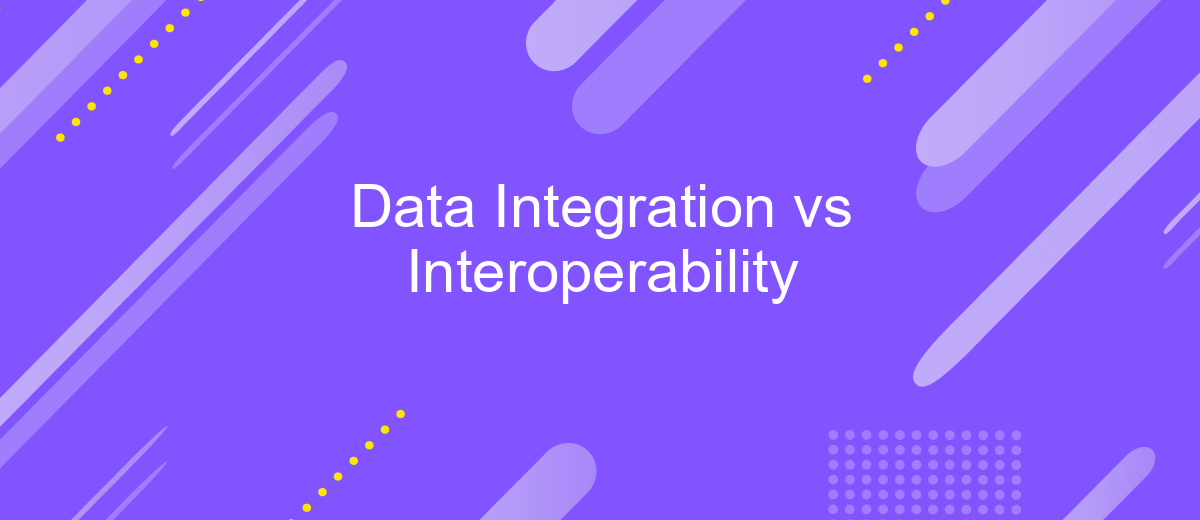Data Integration vs Interoperability
In today's data-driven world, the terms "data integration" and "interoperability" are often used interchangeably, yet they represent distinct concepts crucial for effective information management. Data integration focuses on combining data from various sources into a unified view, while interoperability ensures different systems can communicate and exchange information seamlessly. Understanding these differences is key to optimizing organizational workflows and decision-making processes.
Background
In today's rapidly evolving digital landscape, the concepts of data integration and interoperability play crucial roles in enabling seamless data exchange and utilization across various systems and platforms. While both terms are often used interchangeably, they represent distinct approaches to managing and leveraging data within and between organizations.
- Data Integration: The process of combining data from different sources into a unified view, often involving data transformation, cleansing, and consolidation.
- Interoperability: The ability of different systems, applications, or devices to communicate, exchange, and use data effectively, without requiring significant changes or customizations.
Understanding the differences and synergies between data integration and interoperability is essential for organizations aiming to enhance their data management strategies. By leveraging both concepts appropriately, businesses can ensure more efficient data workflows, improved decision-making processes, and a higher level of data consistency and accuracy across their operations.
Data Integration vs. Data Interoperability

Data integration involves combining data from different sources into a single, unified view, enabling organizations to analyze and utilize this information more effectively. This process often requires sophisticated tools and platforms to handle diverse data formats and ensure accuracy. ApiX-Drive, for instance, offers seamless integration services that simplify the process of connecting various applications and automating data workflows, thereby enhancing operational efficiency and decision-making capabilities.
On the other hand, data interoperability refers to the ability of different systems and software to exchange, interpret, and use data cohesively. It emphasizes the standardization and compatibility of data formats and protocols to ensure seamless communication between disparate systems. Unlike data integration, which focuses on unifying data, interoperability aims to maintain the autonomy of each system while enabling them to work together harmoniously. Both concepts are crucial in modern data management, but they serve distinct purposes and require different approaches and technologies to implement effectively.
Why Data Integration is Important

Data integration is a crucial process in the modern business environment, enabling organizations to combine data from various sources into a single, unified view. This process not only enhances data accessibility but also ensures that decision-makers have comprehensive, accurate, and up-to-date information at their fingertips. Without effective data integration, businesses risk facing data silos, which can lead to inefficiencies and missed opportunities.
- Enhanced Decision-Making: Integrated data provides a holistic view, allowing for more informed and timely decisions.
- Improved Data Quality: By merging data from different sources, inconsistencies and errors can be identified and corrected.
- Operational Efficiency: Streamlining data from multiple systems reduces redundancy and improves workflow efficiency.
- Customer Insights: A unified data view helps in understanding customer behavior and preferences, leading to better customer service and targeted marketing.
- Regulatory Compliance: Integrated data aids in maintaining compliance with industry regulations by providing accurate and complete records.
In conclusion, data integration plays a pivotal role in the success of any organization by providing a comprehensive and accurate data landscape. It not only enhances decision-making and operational efficiency but also improves customer insights and ensures regulatory compliance. As businesses continue to grow and evolve, the importance of effective data integration cannot be overstated.
Why Data Interoperability is Important

Data interoperability is crucial in today's interconnected world where diverse systems need to communicate seamlessly. It ensures that different software applications and platforms can exchange, interpret, and utilize data effectively, leading to more streamlined operations and better decision-making.
Without interoperability, organizations face significant challenges in integrating data from various sources, which can lead to data silos, inefficiencies, and increased costs. Ensuring that systems can work together harmoniously is essential for maximizing the value of data and enhancing overall productivity.
- Facilitates seamless data exchange between different systems
- Reduces redundancies and inefficiencies
- Enables better decision-making through comprehensive data analysis
- Enhances collaboration across departments and organizations
- Supports compliance with industry standards and regulations
In conclusion, data interoperability is not just a technical requirement but a strategic imperative. It empowers organizations to leverage their data assets fully, driving innovation and ensuring they stay competitive in a rapidly evolving digital landscape.


Conclusion
In conclusion, both data integration and interoperability are crucial for ensuring seamless data flow and effective communication between disparate systems. Data integration focuses on combining data from different sources into a unified view, which can be particularly beneficial for organizations seeking to streamline their data management processes. On the other hand, interoperability emphasizes the ability of different systems to work together, sharing and utilizing data efficiently without the need for extensive reconfiguration.
Choosing between data integration and interoperability depends largely on an organization's specific needs and objectives. For those looking to automate and simplify their data processes, services like ApiX-Drive can offer invaluable support. ApiX-Drive facilitates the integration of various applications and services, enabling businesses to achieve a higher level of efficiency and productivity. Ultimately, leveraging the strengths of both approaches can lead to more robust and flexible data ecosystems, empowering organizations to make more informed decisions and drive innovation.
FAQ
What is the difference between data integration and interoperability?
Why is data integration important for businesses?
Can you give an example of how interoperability is used in healthcare?
How can businesses achieve data integration and interoperability?
What are the challenges associated with data integration and interoperability?
Routine tasks take a lot of time from employees? Do they burn out, do not have enough working day for the main duties and important things? Do you understand that the only way out of this situation in modern realities is automation? Try Apix-Drive for free and make sure that the online connector in 5 minutes of setting up integration will remove a significant part of the routine from your life and free up time for you and your employees.

